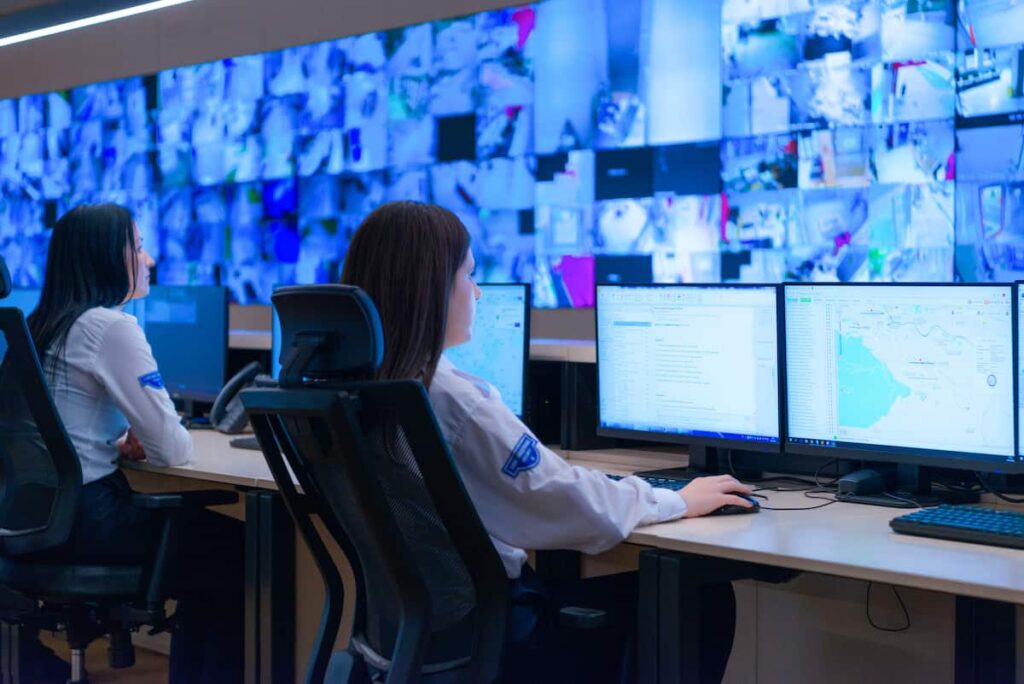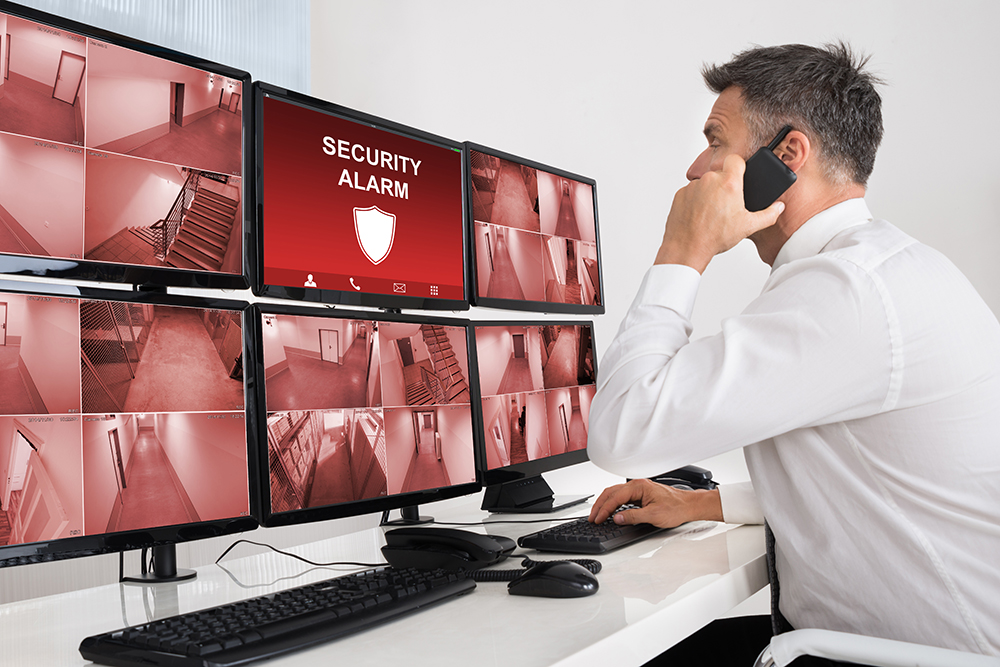Alarm monitoring services are essential in connecting security systems with emergency response teams. These advanced services offer constant surveillance of properties through linked security devices, quickly identifying and addressing potential threats.
The speed at which emergencies are responded to can be the deciding factor between minor incidents and disastrous outcomes. When security breaches, fires, or medical emergencies happen, every second is crucial. A quick response can:
- Prevent loss of life
- Minimise damage to property
- Decrease the risk of theft
- Improve the chances of catching intruders
Modern alarm monitoring service turn traditional security systems into active response networks. Professional monitoring centres operate 24/7, with trained specialists who evaluate alerts, confirm threats, and communicate with emergency services. These centres use advanced technology to process alarm signals within seconds, allowing for rapid deployment of the appropriate emergency personnel.
The combination of real-time monitoring with automated alert systems establishes a strong security framework that greatly decreases response times while improving the effectiveness of emergency interventions.
Understanding Alarm Monitoring Services
Professional alarm monitoring services operate through sophisticated back-to-base monitoring centres that maintain constant vigilance over protected properties. These centres serve as the critical link between security systems and emergency response teams.
How Alarm Monitoring Works
The monitoring process involves:
- Real-time Alert Processing: Advanced systems instantly transmit alarm signals to the monitoring centre when triggered.
- Signal Verification: Trained operators assess incoming alerts through multiple verification methods.
- Emergency Dispatch: Direct communication channels with emergency services enable rapid response deployment.
Who Monitors Your Alarm?
A dedicated team of security professionals staffs these centres 24/7, including:
- Licensed security operators
- Emergency response coordinators
- Technical support specialists
What Else Can the Monitoring Centre Do?
The monitoring centre’s capabilities extend beyond basic alarm response:
“Back-to-base monitoring combines human expertise with cutting-edge technology to provide comprehensive security coverage”
Critical functions include:
- Fire alarm monitoring with direct fire brigade notification
- Panic button response for immediate assistance
- Environmental monitoring for floods, temperature changes, such as using devices like the Poseidon 4002
- Medical alert supervision for vulnerable individuals
How Do We Ensure Continuous Monitoring?
Modern monitoring centres utilise redundant power systems, backup communication networks, and secure data storage to ensure uninterrupted service delivery. The integration of advanced technologies allows operators to:
- Access real-time video feeds
- Control automated security systems remotely
- Track response team locations
- Document all security events systematically
This professional surveillance infrastructure creates a robust security framework that protects properties round-the-clock through systematic monitoring and strategic response coordination.
Components of Integrated Security Systems Supporting Alarm Monitoring
Modern alarm monitoring relies on a sophisticated network of interconnected security components working in harmony to detect, assess, and respond to potential threats.
Essential Detection Components:
- Motion sensors utilising infrared technology to identify movement patterns
- Glass break detectors sensing acoustic frequencies of breaking glass
- Door and window contact sensors monitoring entry points
- Smoke and heat detectors for fire protection
- Panic buttons for immediate emergency alerts
Intrusion Detection Systems
Advanced intrusion detection systems employ multiple sensor types to minimise false alarms whilst maintaining high security. These systems analyse various data points:
- Shock and vibration patterns
- Heat signatures
- Movement sequences
- Sound frequencies
CCTV Surveillance Integration
High-resolution cameras serve as the eyes of the monitoring system:
- Cloud-enabled storage for secure footage retention
- Night vision capabilities for 24/7 monitoring
- Motion-activated recording to capture relevant events
- Remote access through secure mobile applications
Access Control Systems
Modern access control enhances security through:
- Biometric scanners reading unique physical identifiers
- Smart card readers with encryption technology
- PIN-protected keypads
- Mobile credentials for touchless entry
- Time-stamped entry logs for comprehensive audit trails
The integration of these components creates a robust security infrastructure, enabling monitoring centres to receive precise information about potential security breaches and respond with appropriate measures based on real-time data.
Video Monitoring Integration and Its Role in Emergency Response
Video monitoring integration transforms traditional alarm systems into powerful security solutions that dramatically reduce emergency response times. The combination of video surveillance with alarm monitoring creates a robust verification system that enables security personnel to assess situations in real-time.
Key Benefits of Integrated Video Monitoring:
- Instant visual verification of alarm triggers
- Remote assessment capabilities for security teams
- Reduced false alarm rates through visual confirmation
- Enhanced situational awareness for emergency responders
Modern event-based recording systems capture crucial moments with precision. When an alarm activates, the system automatically records pre and post-event footage, ensuring no critical details are missed while optimising storage space.
Cloud-enabled high-resolution cameras provide unprecedented accessibility and reliability. Security personnel can access live feeds and recorded footage through dedicated mobile applications, enabling:
- Real-time situation assessment from any location
- Immediate sharing of visual data with emergency services
- Secure storage of incident footage
- Multi-device access for authorised personnel
The integration of video evidence significantly accelerates incident handling by law enforcement. Police and emergency services receive detailed visual information before arriving on scene, allowing them to:
- Plan appropriate response strategies
- Identify potential threats or hazards
- Deploy the right resources
- Track perpetrator movements in real-time
This comprehensive approach to security monitoring creates a more efficient emergency response system, where every second saved can make a critical difference in protecting lives and property. The role of video monitoring integration in this process is invaluable, as it not only enhances the effectiveness of emergency responses but also contributes to better planning and resource allocation. Moreover, the insights gained from such integrated systems can be instrumental in future research and development within the field of security and emergency management.
Verification Processes to Reduce False Alarms in Alarm Monitoring Services
False alarms create significant challenges for emergency services, draining resources and increasing response times for genuine emergencies. Research indicates that up to 94-98% of alarm activations can be false alerts, costing emergency services millions annually in wasted responses.
Modern alarm monitoring services implement robust verification protocols to combat this issue:
1. Enhanced Call Verification (ECV)
- Multiple contact attempts to designated keyholders
- Cross-checking with secondary sensors
- Audio/visual verification through integrated systems

2. Multi-Step Authentication
- Zone-specific activation analysis
- Weather condition assessment
- Historical pattern evaluation
3. Smart Technology Integration
- AI-powered motion detection
- Pet-immune sensors
- Environmental factor filtering
These verification methods have demonstrated a 30-50% reduction in false dispatches while maintaining rapid response capabilities for genuine threats. Professional monitoring centres analyse each alert through multiple verification layers, ensuring emergency services are deployed only for confirmed security breaches.
The implementation of strict verification protocols creates a more efficient emergency response system, allowing resources to be directed where truly needed.
Impact on Emergency Response Times Through Verified Alarms in Alarm Monitoring Services
Verified alarms dramatically reduce emergency response times through precise, data-driven decision-making. When monitoring centres receive verified alarms, dispatchers can immediately assess the situation’s severity and deploy appropriate resources without hesitation.
Real-time Information Access:
- Live video feeds enable instant threat assessment
- Mobile apps provide GPS coordinates for exact location tracking
- Remote monitoring centres share critical data with emergency responders
Enhanced Situational Awareness:
- Security personnel receive instant notifications with detailed incident information
- Interactive floor plans highlight affected areas
- Two-way communication systems enable direct contact with on-site personnel
The integration of mobile technology allows security teams to access vital information anywhere, anytime. Emergency responders arrive at scenes with comprehensive knowledge of the situation, including:
- Entry point locations
- Potential hazards
- Number of people involved
- Nature of the emergency
- Real-time updates as the situation evolves
This advanced level of situational awareness enables emergency teams to develop targeted response strategies before reaching the scene, significantly reducing critical response times.
Benefits Beyond Faster Emergency Responses in Alarm Monitoring Services
Alarm monitoring services deliver substantial advantages extending far beyond rapid emergency responses. The presence of visible security measures acts as a powerful deterrent to potential intruders. Research indicates that properties with monitored security systems experience 75% fewer break-in attempts compared to unprotected premises.
Financial Benefits Through Reduced Insurance Premiums
The financial benefits of professional monitoring services prove significant through reduced insurance premiums. Many insurance providers offer discounts ranging from 10% to 20% for properties equipped with:
- 24/7 professional monitoring
- Back-to-base alarm systems
- Video surveillance
- Access control integration
Creating Multiple Layers of Protection
These comprehensive security measures create multiple layers of protection:
- Active deterrence through visible cameras and warning signs
- Real-time threat detection and assessment
- Documented evidence collection
- Controlled access management
The combination of these elements establishes a robust security framework that safeguards assets, protects occupants, and creates long-term cost savings through reduced risk exposure and enhanced insurance benefits.
Tailored Alarm Monitoring Solutions Across Different Sectors
Modern alarm monitoring adapts to specific industry requirements through customised security solutions:
Residential Applications
- Smart home integration with voice-controlled security systems
- Mobile app notifications for package deliveries and visitor access
- Automated lighting schedules mimicking occupancy patterns
- Remote temperature and environmental monitoring
- Video doorbell systems with two-way communication
Commercial Solutions
- Multi-site monitoring from centralised control rooms
- Employee access tracking and time attendance systems
- Restricted area management with biometric authentication
- Mobile patrol integration with GPS tracking
- Asset protection through RFID inventory monitoring
These sector-specific solutions create layered security approaches matching unique operational demands. Residential systems prioritise user-friendly interfaces and lifestyle integration, while commercial applications focus on workflow efficiency and risk management. The scalability of modern monitoring platforms allows security providers to adjust protection levels based on threat assessments and compliance requirements.
Case Study Highlight: Alpha Security Corp’s Integrated Approach to Alarm Monitoring Services
Alpha Security Corp is a shining example of excellence in integrated security solutions, with over 25 years of industry experience. The company’s comprehensive approach to alarm monitoring services showcases the practical application of cutting-edge security integration.
Their signature unified platform exemplifies modern security integration:
- Smart Hub Integration: A centralised control system connecting multiple security components
- Real-Time Synchronisation: Seamless communication between access control, CCTV, and alarm systems
- Automated Response Protocols: Pre-programmed security responses based on specific trigger events
A recent implementation at a multi-storey commercial complex showcases Alpha Security Corp’s capabilities:
“The integrated system detected unauthorised access attempts, automatically activated CCTV recording, and alerted the monitoring centre – all within 3 seconds. This coordinated response led to the apprehension of potential intruders before any property damage occurred.”
The company’s platform enables:
- Instant cross-referencing between different security components
- Automated event logging and reporting
- Remote system management via secure mobile applications
- Customisable alert protocols based on threat levels
This integrated approach has resulted in a 40% improvement in response times and a 60% reduction in false alarms across Alpha Security Corp’s client base.

Conclusion
Professional alarm monitoring services are a crucial part of modern security systems. By combining advanced technology with skilled professionals, they provide strong protection against potential dangers and ensure quick responses in emergencies.
The measurable benefits of professional monitoring services include:
- Reduced response times through immediate threat verification
- Enhanced property protection via 24/7 surveillance
- Improved safety outcomes for residents and businesses
- Decreased financial losses from theft and property damage
- Lower insurance premiums due to comprehensive security measures
The ongoing development of alarm monitoring technology continues to strengthen the link between security systems and emergency responders. Features like smart integrations, video verification, and real-time communication have shifted security from being reactive to proactive.
Investing in professional alarm monitoring services provides peace of mind with constant watchfulness and quick action when every second counts. These services are essential for protecting lives, securing assets, and maintaining safety in an increasingly complicated world.
See Also: What is Back-to-Base Alarm Monitoring and why does it matter?.

